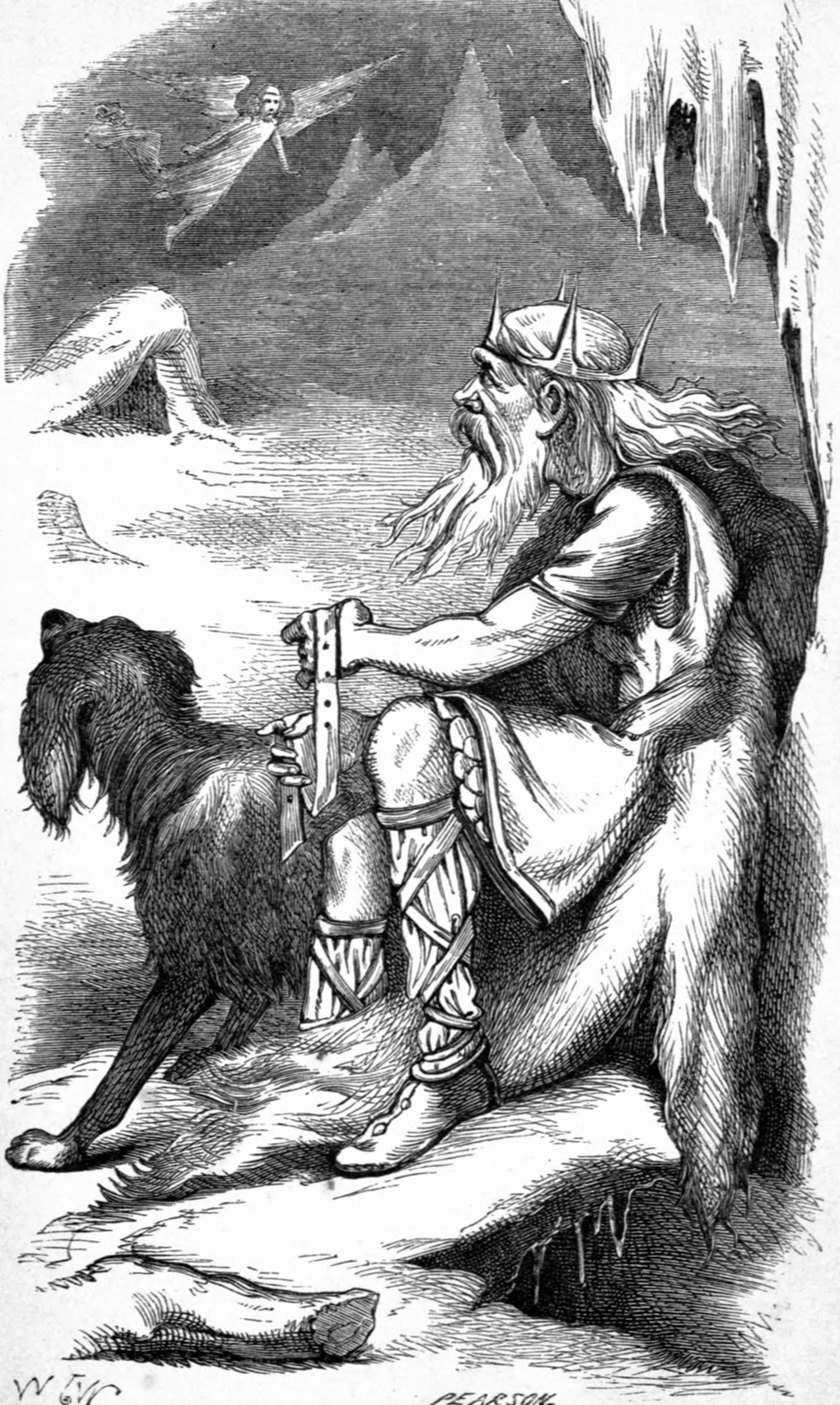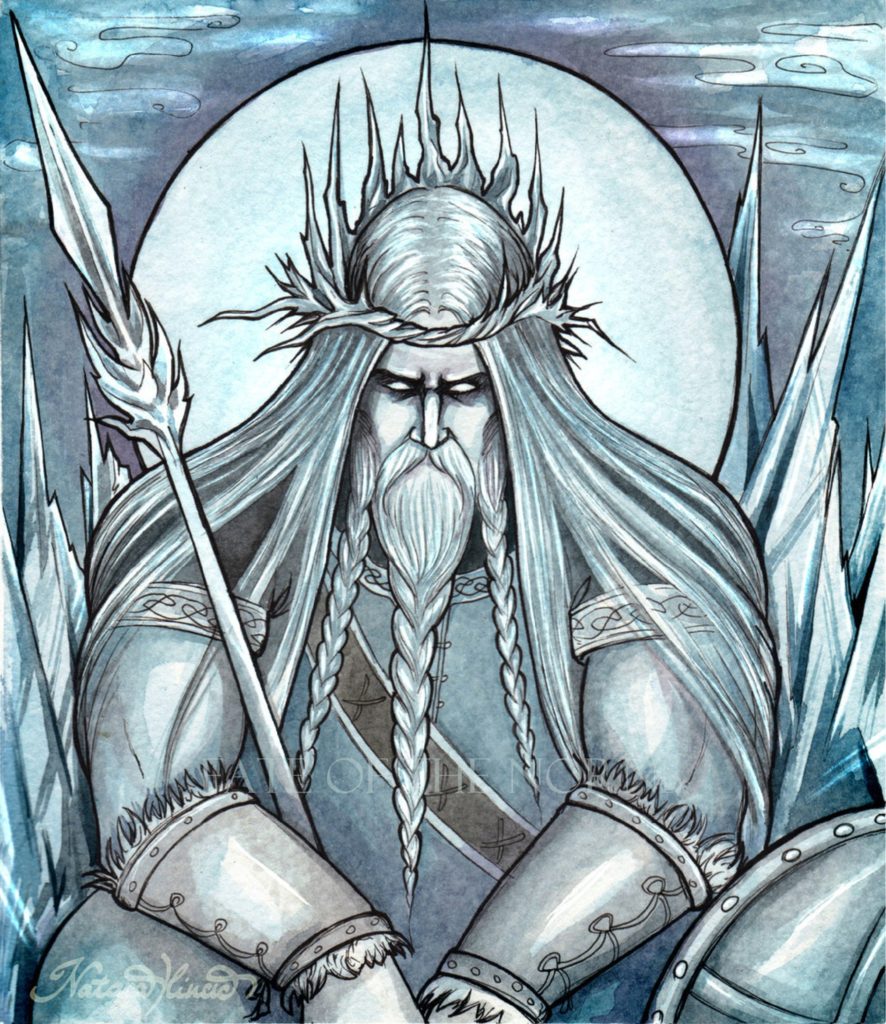
Þrymr
The jötunn who stole Thor’s hammer Mjöllnir. He is solely attested in the eddic poem Þrymskviða.
One morning, upon waking, Thor discovers that his hammer is missing. He tells Loki and together they go to Freyja’s dwelling to borrow her feather-dress so that he might go looking for his hammer, and Freyja consents. Loki dons the feather-dress and flies until he reaches Jötunheimr. He sees Þrymr sitting on a mound and asks him if he has hidden Hlórriði‘s hammer. The giant confirms that he has hidden it eight miles deep in the earth and says that it will remain there unless Freyja is given to him as his wife.
Loki returns to Ásgarðr and tells Thor that Þrymr has his hammer but that he will not get it back unless they bring Freyja. They go to Freyja and instruct her to put on her bridal dress and come with them to Jötunheimr. Freyja is furious and refuses to go, so the gods hold council how they might get the hammer back. Heimdallr proposes that Thor disguises himself as the goddess, wearing a woman’s dress, a veil, and the Brísinga necklace. Thor reluctantly agrees. Continue reading HERE.
Þrymskviða
The Lay of Thrym
The Thrymskwitha is one of the very best of the Eddie poems. It is the dramatic story of how Thor, aided by Loki, got back his famous hammer. Thrym had stolen it, and he would not give it up until they would bring him Freyja to wife; but she very indignantly refused to get married under any such terms. It is finally arranged, though much against his will, that Thor himself must dress up to impersonate Freyja, and go up to get married to the giant Thrym. The latter half of the poem contains the carrying out of this plan. But Thor is the great thunder-god. He is the largest and strongest of them all, and a ravenous eater and drinker. The story is elsewhere told of him that once, in a drinking contest, he lowered the sea several inches. It is he alone that was not allowed to walk over the bridge of the rainbow for fear he might break it down. What could be more incongruous and ludicrous, then, than to have this great clumsy god dress up as Freyja, the fairest of the goddesses, and to go off in her name to marry the ice-giant Thrym! The Norse poet has made good use of his opportunities, and we have in this poem a masterpiece of its kind. Continue reading HERE.

Thrymr Moon of Saturn

Discovery
Thrymr was discovered in 2000 by Brett J. Gladman, John J. Kavelaars, Jean-Marc Petit, Hans Scholl, Matthew J. Holman, Brian G. Marsden, Phillip D. Nicholson, and Joseph A. Burns using the 3.6-m Canada-France-Hawaii reflector on Mauna Kea in Hawaii, with adaptive optics. They discovered seven other Saturnian moons at the same time: Tarvos, Ijiraq, Suttungr, Skathi, Siarnaq, Erriapus, and Mundilfari.
Overview
Thrymr has a mean radius of 2.2 miles (3.5 kilometers), assuming an albedo (a measure of how reflective the surface is) of 0.06. It orbits Saturn at an inclination of about 174 degrees and an eccentricity of about 0.5. At a mean distance of 12.7 million miles (20.4 million kilometers) from Saturn, the moon takes about 1,094 Earth days to complete one orbit.
Thrymr is a member of the Norse group of moons. These “irregular” moons have retrograde orbits around Saturn – traveling around in the opposite direction from the planet’s rotation. Thrymr and the other Norse moons also have eccentric orbits, meaning they are more elongated than circular.
Like Saturn’s other irregular moons, Thrymr is thought to be an object that was captured by Saturn’s gravity, rather than having accreted from the dusty disk that surrounded the newly formed planet as the regular moons are thought to have done.
How Thrymr Got Its Name
Originally called S/2000 S7, Thrymr was named for a giant in Norse mythology who stole Thor’s hammer and offered to return it only if the gods gave him the very beautiful goddess Freyia to be his wife. The gods agree, but instead send Thor, disguised as Freyia. Thor as Freyia orders the hammer to be placed on “her” knee, whereupon Thor uses the hammer to kill Thrymr, along with the giant’s sister, who had asked for “Freyia’s” rings. SOURCE
Further Resources:
